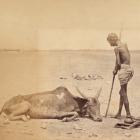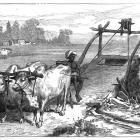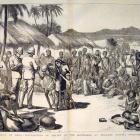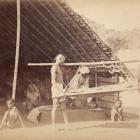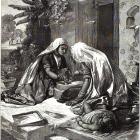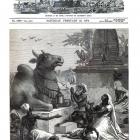Further reading
Abhirajan, S. “Malthusian Population Theory and Indian Famine Policy in the Nineteenth Century.” Population Studies 30 (1976): 5–14.
Arnold, David. Famine: Social Crises and Historical Change. London: Basil Blackwell, 1988.
———. “Social Crises and Epidemic Disease in the Famines of nineteenth-Century India.” Social History of Medicine 6 (1993): 385–404.
———. “The ‘Discovery’ of Malnutrition and Diet in Colonial India.” Indian Economic and Social History Review 31, no. 1 (1994): 1–26.
Ball, Valentine. “On the Products Used as Articles of Food by the Inhabitants of the District of Manbhum and Hazaribagh.” Journal of the Asiatic Society of Bengal 36, no. 2 (1867): 73–82.
———. “Notes on the Kherias, an Aboriginal Race Living in the Hill Tracts of Manbhum.” In Proceedings of the Asiatic Society of Bengal, edited by The General Secretary. Calcutta: Baptist Mission Press, 1868.
———. “On Jungle Products Used as Articles of Food in Chutia Nagpur.” In Tribal and Peasant Life in Nineteenth Century India, edited by The General Secretary. New Delhi: Usha Publication, 1880.
Bhatia, Balmokand M. Famines in India: A Study in Some Aspects of the Economic History of India. London and New Delhi: Asia Publishing House, 1967.
Blyn, George. Agricultural Trends in India 1891-1947: Output, Availability and Production. Philadelphia: University of Pennsylvania Press, 1966.
Bose, Sudhindra. Some Aspects of British Rule in India. Iowa City: University of Iowa, 1918.
Caldwell, John. “Malthus and the Less Developed World: The Pivotal Role of India.” Population and Development Review 24, no. 4 (December 1998): 675–96.
Damodaran, Vinita. “Famine in a Forest Track: Ecological Change and the Causes of the 1897 Famine in Chotanagpur, Northern India.” In Nature and the Orient: Essays on the Environmental History of South and Southeast Asia, edited by Grove, R., Damodaran, Vinita, and Sangwan, Satpal, 853–90. New Delhi: Oxford University Press, 1998.
Headrick, Daniel R. The Tentacles of Progress: Technology Transfer in the Age of Imperialism, 1850-1940. Oxford: Oxford University Press, 1988. 78–79.
Davis, Mike. Late Victorian Holocausts: EI Niño Famine and the Making of the Third World. London: Verso Books, 2001.
Dreze, Jean. “Famine Prevention in India.” In The Political Economy of Hungry: Famine Prevention, edited by Jean Dreze and Amartya Sen. Oxford: Oxford University Press, 1991.
Dutt, Ramesh. The Economic History of India. New Delhi: Publication Division, Ministry of Information and Broadcasting, Government of India, 1960.
Dyson, Tim. “On the Demography of South Asian Famines, Part I.” Population Studies 45, no. 1 (1991): 5–25.
———. “On the Demography of South Asian Famines, Part II.” Population Studies 45, no. 2 (1991): 179–97.
Ertem, Özge. ”British Views on the Indian and Ottoman Famines: Politics, Culture, and Morality,” In RCC Perspectives: The Imagination of Limits. Exploring Scarcity and Abundance, edited by F. Felcht and K. Ritson, 17-29. Munich, 2015. http://www.environmentandsociety.org/perspectives/2015/2/imagination-limits-exploring-scarcity-and-abundance.
The Indian Famine Commission. Report. Calcutta: Office of the Superintendent of Government Printing, India, 1898.
Fieldhouse, David. “For Richer, for Poorer?” In The Cambridge Illustrated History of the British Empire, edited by Peter J. Marshall. Cambridge: Cambridge University Press, 1996. 108–46.
Fried, Morton. The Notion of Tribe. Melo Park: California Cummings Pub. Co.,1975.
Gadgil, Madhav, and Guha, Ramachandra. The Fissured Land: An Ecological History of India. Delhi: Oxford University Press, 1992.
Ganguli, B. N. Dadabhai Naoroji and the Drain Theory. Bombay: Asia Publishing House, 1965.
Ghate, Rucha S. Forest Policy and Tribal Development: A Study of Maharashtra. New Delhi: Concept Publishing Company, 1992.
Ghosal, Somnath. “Pre-Colonial and Colonial Forest Culture in the Residency of Bengal.” Human Geographies 5, no. 1 (2011): 107–16.
Ghose, Ajit K. “Food Supply and Starvation: A Study of Famines with Reference to the Indian Subcontinent”, Oxford Economic Papers, New Series 34, no. 2 (1982): 368–89.
Ghosh, Kali Charan. Famines in Bengal, 1770-1943. Calcutta: India Associated, 1944.
Grove, Richard H. “The Great EI Niño of 1789–93 and its Global Consequences: Reconstructing an Extreme Climate Even in World Environmental History.” The Medieval History Journal 10, no. 1&2 (2007): 75–98.
Gupta, Anil K. “Origin of Agriculture and Domestication of Plants and Animals Linked to Early Holocene Climate amelioration.” Current Science 87, no. 1 (2004): 54–59.
Hall-Matthews, David. “The historical Roots of Famine Relief Paradigms.” In A World Without Famine? New approach to aid and Development, edited by Helen O’Neill and John Toye, 107–27. Basingstok: Macmillan, 1998.
———. “Inaccurate Conceptions: Disputed Measures of Nutritional Needs and Famine Deaths in Colonial India.” Modern Asian Studies 42, no. 1 (2008): 1–24.
Harris, David R. and Gosden, Chris. The Origins and Spread of Agriculture and Pastoralism in Eurasia: Crops, Fields, Flocks and Herds. Routledge, 1996.
Hurd, John. “Railways and the Expansion of Markets in India 1861–1921” Explorations in Economic History 12 (1975): 263–88.
———. “Railways.” In Cambridge Economic History of India vol. II, edited by Dharma Kumar. Cambridge: Cambridge University Press, 1983.
Frowde, Henry. The Indian Empire, Economic. Imperial Gazetteer of India, vol. III. Oxford: Clarendon Press, 1907.
Klein, Ira. “Death in India, 1871–1921” The Journal of Asian Studies 32, no. 4 (1973). 639–59.
———, “When the Rains Failed: Famine, Relief, and Mortality in British India.” The Indian Economic and Social History Review 21, no. 2 (1984): 185–214.
Koomar, Basanta Roy. The Labor Revolt in India. New York: Friends of Freedom for India, 1920.
Kumar, Ravinder. “The Deccan Riots of 1875” The Journal of Asian Studies 24, no. 4 (1965): 613–35.
Levine, Philippa. “Venereal Disease, Prostitution, and the Politics of Empire: The Case of British India” Journal of the History of Sexuality 4, no. 4 (1994): 579–602.
Mahato, Nirmal Kumar. “Environmental Change and Chronic Famine in Manbhum, Bengal District, 1860–1910.” Global Environment 6 (2010): 83–84.
Majumdar, Ramesh Chandra, Raychaudhary, Hemchandra. C., and Datta, Kalikinkar. An Advanced History of India. Madras: Macmillan India Limited, 1981.
McApline, Michelle, B. “Dearth, Famine, and Risk: The Changing Impacts of Crop Failures in Western India, 1870–1920.” The Journal of Economic History 39 (1979): 143–57.
Naoroji, Dadabhai. Poverty and British Rule in India. London: Swan Sonnenschein & Co, 1901.
Rangarajan, Mahesh. Fencing the Forest: Conservation and Ecological Change in India’s Central Provinces, 1860–1914. Delhi: Oxford University Press, 1996.
Ravallion, Martin “Trade and Stabilization: Another Look at British India’s Controversial Foodgrain Export.” Exploration in Economic History 24, no. 4 (1987): 358–70.
Roy, Tirthankar. “A Delayed Revolution: Environment and Agrarian Change in India”. Oxford Review of Economic Policy 23, no. 2 (2007): 239–50.
Sami, Leela. “Starvation, Disease and Death: Explaining Famine Mortality in Madras 1876–1878.” Social History of Medicine 24, no. 3 (2011): 700–19.
Satya, Laxman D. Cotton and Famine in Berar, 1850–1900. Massachusetts: Tufts University, 1994.
Sen, Amartya. Poverty and Famine: An Essay on Entitlement and Deprivation. Oxford: University Press, 1981.
Sinha, D. “Proletarization of a Hunting and Gathering Tribe: The Case of Hill Khera of Purulia” In Changing Land Systems and Tribals of Eastern India in the Modern Period, edited by Tarasankar Banerjee, 73–74. Calcutta: Subarnarekha, 1989.
Stokes, Eric. The English Utilitarians and India. Oxford: Oxford University Press, 1959.
Thorner, Daniel “The Pattern of Railway Development in India.” Far Eastern Quarterly no. 14 (1955): 201–206;
Weil, Ben. “Conservation, Exploitation, and Cultural Change in Indian Forest Service 1875-1927.” Environmental History 11, no. 2 (2006): 319–43.
Whitecombe, Elizabeth. “Famine Mortality.” Economic and Political Weekly 28, no. 1 (1993): 69–79.
- Previous chapter
- Next chapter






